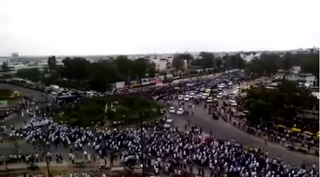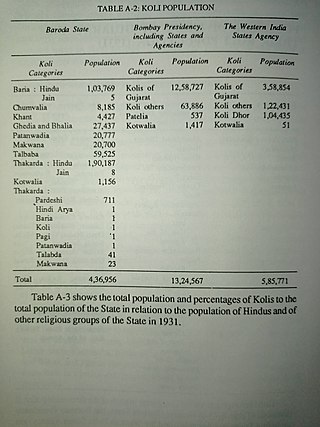Related Research Articles
Patel is an Indian surname or title, predominantly found in the state of Gujarat, representing the community of land-owning farmers and later businessmen, agriculturalists and merchants. Traditionally the title is a status name referring to the village chieftains during medieval times, and was later retained as successive generations stemmed out into communities of landowners. There are roughly 500,000 Patels outside India, including about 150,000 in the United Kingdom and about 150,000 in the United States. Nearly 1 in 10 people of Indian origin in the US is a Patel.
Parmar, also known as Panwar or Pawar, is a Rajput clan found in Northern and Central India, especially in Rajasthan, Gujarat, Punjab, Haryana, Uttarakhand, Uttar Pradesh, Bihar, Madhya Pradesh and North Maharashtra. The clan name is also used by Kōḷīs, Garoḍās, Līmaciyā Valands, Mōcīs, Tūrīs, Luhārs, Kansārās, Darajīs, Bhāvasārs, Cūnvāḷiyās, Ghañcīs, Harijans, Sōnīs, Sutārs, Dhobīs, Khavāsas, Rabārīs, Āhīrs, Sandhīs, Pīñjārās, Vāñjhās, Dhūḷadhōyās, Rāvaḷs, Vāgharīs, Bhīls, Āñjaṇās, Mer and Ḍhēḍhs.

Patidar, formerly known as Kanbi, is an Indian land-owning and peasant caste and community native to Gujarat. The community comprises at multiple subcastes, most prominently the Levas and Kadvas. They form one of the dominant castes in Gujarat. The title of Patidar originally conferred to the land owning aristocratic class of Gujarati Kanbis; however, it was later applied en masse to the entirety of the Kanbi population who lay claim to a land owning identity, partly as a result of land reforms during the British Raj.
Jethwa is a clan of Rajputs and Koli castes of Gujarat. Jethwa surname is also found among Darji, Mistris of Kutch, Gurjar Kshatriya Kadias castes of Gujarat
Jhala is a Rajput clan. They are found in Rajasthan and Gujarat state of India. The clan is also found among Koli castes as Jala.
Kutch Gurjar Kshatriya are a minority Hindu community of Gujarat in India, who claim to be Kshatriyas. They are an artisan community related with masonry, artistic carvings, sculpting and building and construction works. They are also known as the Mistri or Mistris of Kutch.

The Pateliya, or Patelia or Patel is a landowning Subcaste of Koli caste found in the Indian states of Gujarat. During the British Raj in India, Patelia Kolis served as tax collectors and administrators. The name Patelia comes from a word meaning village chief. Many Patelia Kolis also went into business and commerce during the Raj period. Patelia Kolis are part of Talapada Kolis of Gujarat.

Nadoda are a Rajput community found in the state of Gujarat, India.They are notable for their historic refusal to pay taxes to the sultans.

The Rathva or Rathwa also spelled as Rathava and Rathawa is a Subcaste of the Koli caste found in the Indian state of Gujarat. Rathava Kolis were agriculturist by profession and turbulent by habits but now lives like Adivasis such as Bhil because of their neighborhood
The Vala, or Wala is a Gujarati clan (Gotra) mostly found among Koli, Rajput and Kathi castes of Gujarat.
Mahyavanshi are Rajput Caste in india and dominant caste.

Baria, or Baraiya,Bareeya and Bariya is a clan (Gotra) of the Koli caste found in the Indian State of Gujarat and Dadra and Nagar Haveli and Daman and Diu. the Devgad Baria was their Stronghold or given their name to Baria State in Gujarat. according to the historian Y.V.S Nath, the ruling royal family of Baria State is original Koli by caste but later they claimed to be of Rajput origin to be in high status among other Princely States.

The Koli is an Indian caste found in Rajasthan, Himachal Pradesh, Gujarat, Maharashtra, Uttar Pradesh, Haryana, Karnataka, Odisha and Jammu and Kashmir states in India. Koli is an agriculturist caste of Gujarat but in coastal areas they also work as fishermen along with agriculture. In the beginning of 20th century, the Koli caste was recognised as a denotified tribe under Criminal Tribes Act by the Indian Government because of their anti-social activities during World War I.
gurjar kshtriya / Kadiya kshtriya are a Hindu sub-group of the kshtriya caste, which are found only in Gujarat, India. They are among the Socially and Educationally Backward Classes of Gujarat State.
The Chavda Koli, is a clan of Hindu Koli community living in the Indian state of Gujarat and union Territory of Daman and Diu.

The Chunvalia, or Chuvalia, Chunwalia is a subcaste of the Koli caste, found in the Indian state of Gujarat. The Chunvalia Kolis were the first Indian caste to adopt the game of cricket in India. Chunvalia Kolis were classified as a Criminal Tribe under Criminal Tribes Act by government of the British Raj because of their purported anti-social behaviour and activities, such as alleged dacoity in Gujarat. During the First World War, Chunwalia Kolis were enlisted as soldiers in British Indian Army by the Bombay government of British India.
Varu is a surname of Indian origin, found among the people from Kutch and Saurashtra regions in the state of Gujarat in India and diaspora of people of India. Outside India, Varu surname occurs in people of United Kingdom, Papua New Guinea, Cook Islands & Canada.
Pagi is a title used by the Koli caste of the Indian state of Gujarat during the rule of Mughals, Muslims, British, and princely states in British India. They specialised in the tracking of thieves by means of their footprints. Pagi was a title equal to the detective conferred on the Kolis of Talpada and Chunwalia subcastes.
The Talapada, or Talpada, is a subcaste of the Koli caste of Gujarat state in India. Talapada Kolis are agriculturists by profession. they were members of the Gujarat Kshatriya Sabha, an organisation launched by Natwarsinh Solanki who was a Koli elite. In 1907, they were classified by the British as a Criminal Tribe, ascribing to them a range of anti-social activities such as highway robbery, murder, and theft of animals, cattle and standing crops. They were also alleged to be blackmailers and hired assassins.
The Chauhan Koli is a clan (gotra) of the Koli caste living in the Gujarat and Rajasthan states in India.
References
- ↑ Desai, Govindbhai Hathibhai (2007). Mother America. New Delhi, India. pp. 43: KADIA-It is an occupational name sometimes wrongly returned as a caste name by bricklayers who belong to Kachhin, Gola, Chhipn, Sathawara, Kanbi, Koll and other castes.
{{cite book}}: CS1 maint: location missing publisher (link) - ↑ Tyabji, Azhar (2006). Bhuj: Art, Architecture, History. New Delhi, India: Mapin. pp. 283: Gurjar Kadia community of masons. ISBN 978-1-890206-80-2.
- ↑ People of India: India's communities. New Delhi, India: Oxford University Press. 1998. p. 1439. ISBN 978-0-19-563354-2.
- 1 2 People of India: India's communities. New Delhi, India: Oxford University Press. 1998. pp. 1775: The Koli have three endogamous divisions based on occupation, namely Macchi Koli, Khedut Koli and Kodiya Koli or Kadia Koli. The Kodiya Koli are placed lowest with the Machi Koli in the hierarchical order. Besides, they have fifteen clans (got), such as Solanki, Bamania. Baria, Rathod, Chudasma and Makwana, which are common to all the subdivisions. ISBN 978-0-19-563354-2.